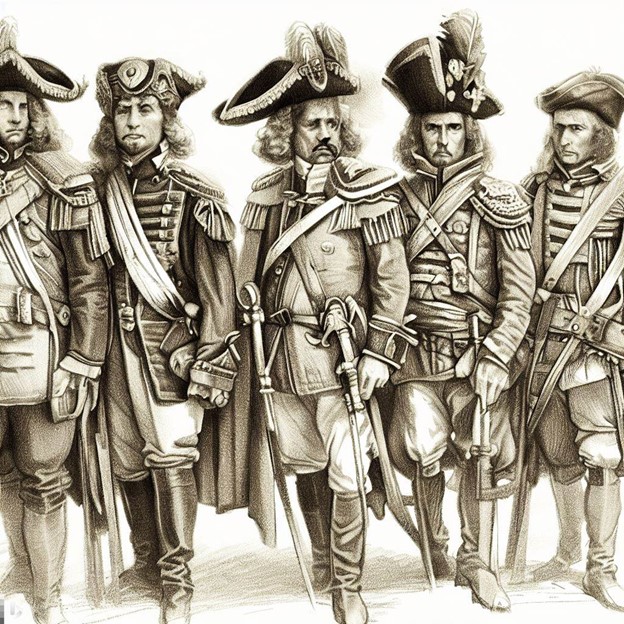French Warriors from Turtle Island colony in the 17th Century – DALL-E Image Creator
I remember being disappointed as an eight-year-old learning ‘Canada’s Story’ in primary school.
I wanted to know where I came from and to learn about the world. I learned about Jacques Cartier, Christopher Columbus, and John Cabot, who were supposed to have discovered America. But how could they have discovered it when people were already here?
I imagined my French ancestors marching noisily through the forest when as if from nowhere, they were confronted by descendants of the first peoples of what we now call North America. Their excitement and terror were palpable to an eight-year-old me.
I wanted to know about these first people.
I am what Indigenous people today call a “settler.” Some settler folks would refer to me as an “old stock Canadian.” Somehow, though, my closest relations, who began arriving in the 19th century from Europe, wouldn’t be very old stock when compared to more distant relations amongst Canada’s first peoples.
Recently, I was introduced to the work of anthropologist Paulette Steeves.
Her book (THE INDIGENOUS PALEOLITHIC OF THE WESTERN HEMISPHERE) was published in 2021. It mines evidence from archaeological sites, Paleolithic environments, and landscapes. It considers mammalian and human migrations. Together these make the case that people have been in the Western Hemisphere not only just before the first known Clovis sites (10,200 years ago) but for more than 60,000 years, and likely more than 100,000 years.
Faced with that kind of timeframe, Canadian – and even European civilizations – seem a little self-centered and mired in adolescence. It’s as though we’re still trying to figure out who we are and what we’re capable of.
According to Steeves:
“History always includes those rare people who stepped outside the box of contemporary thought and the status quo of academic discussions to follow their own paths. Archaeology is no exception; a small group of American and European archaeologists has discussed alternatives to the Clovis First hypothesis. Archaeologists such as Tom Dillehay, Allan Goodyear, James Adovasio, Ruth Gruhn, Alan Bryan, Joseph and Lynn McAvoy, Steve and Kathleen Holen, Niède Guidon, Scotty MacNeish, Jacques Cinq-Mars, Virginia Steen-McIntire, Thomas Lee, and many others have worked to highlight the past of the Americas as an unknown place and time that require a great deal more research. Despite facing certain academic bashing and potential career destruction, numerous archaeologists and geologists over the last eighty years have reported dates for archaeological sites that were earlier than 12,000 years ago.”
She takes issue with the traditional view of the establishment within her field.
“However, regarding the Western Hemisphere, archaeological discussions have created the so-called Clovis People, a single pan-hemispheric cultural group that covered two continents with extremely diverse environments. Such oversimplified theories based on one stone tool type erase the diversity known to be present in the archaeological record, oral traditions, and linguistics. This is the same as saying that all people in the Americas who used guns in the twentieth century were a single cultural group. The “Gun People” were a pan-hemispheric cultural group of hunters who caused the extinction of many species through reckless hunting practices and waged savage wars against peaceful non-gun people, mailboxes, road signs, and beer bottles.“
Her comparison of the “Clovis point people” with the invented pan-hemispheric cultural group called the “gun people” is priceless.
Somehow, she has muscled her way into the often-toxic environment of academia. I wish her every success in her quest.
Contemporary Western universities have their origins in Medieval Europe. They are strangely resourceful beasts that have survived the evolution of European Christianity and contemporary neo-classical economics. They’ve had a significant role in disseminating the Doctrine of Discovery and, more recently, have often confused Adam Smith’s ‘invisible hand’ with the “Hand of God.”
In the increasingly polarized world of today, we are witnessing the emergence of “red and blue” universities that coincide with “red and blue” states and political interests in our neighbours to the south. It doesn’t feel like we’re very far behind in Canada.
Too often, instead of places for critical thinking, universities have become necessary to earn credentials for future careers. Business schools promote ‘business school orthodoxy’, while many of the social sciences have their own unique ‘orthodoxies’. Instead of encouraging discussion, distinct schools have weaponized their own ways of understanding.
In the eighth chapter, she talks of a cleansing fire:
“A traditional practice of caring for the land in many Indigenous areas, pyro regeneration burns away old dense forest cover and allows the sunlight to bring new life to the earth. Pyro regeneration is a ceremony of cleansing and rebirth. This is a fitting metaphor for the critical scholarship of colonial knowledge production and epistemologies of agnotology. In 2012 I coined the word “pyroepistemology” to describe critical Indigenous scholarship and decolonization of discussions of the Indigenous past and present. The fire, being critical Indigenous scholarship, flames away through critical discussions layers of biased colonial thought to allow room for new frames of knowledge to take hold in academia. Pyroepistemology is one flame of many that fuel the Eighth Fire, thus bringing the healing smoke of Indigenous knowledge as the wind that fans the flames and transgresses a dehumanizing Eurocentric knowledge production.
Dr. Steeves’s work is important. Her book is a great way for students of all ages and backgrounds to become better critical thinkers.

